ASRock Brings Zen 2 NUC : 4X4 BOX-4800U Renoir Mini-PC Reviewed
by Ganesh T S on November 25, 2020 11:00 AM ESTSPECworkstation 3 Benchmark
The diminutive 4X4 BOX-4800U is not a workstation by any stretch of imagination. As an academic exercise, it is definitely interesting to look at how the system performs on a comparative basis across various professional applications. The SPECworkstation 3 benchmark measures workstation performance based on such applications. It includes more than 140 tests based on 30 different workloads that exercise the CPU, graphics, I/O and memory hierarchy. These workloads fall into different categories.
- Media and Entertainment (3D animation, rendering)
- Product Development (CAD/CAM/CAE)
- Life Sciences (medical, molecular)
- Financial Services
- Energy (oil and gas)
- General Operations
- GPU Compute
Individual scores are generated for each test and a composite score for each category is calculated based on a reference machine (HP Z240 tower workstation using an Intel E3-1240 v5 CPU, an AMD Radeon Pro WX3100 GPU, 16GB of DDR4-2133, and a SanDisk 512GB SSD). The SPEC Ratio for the tests in each category is presented in the graphs below.
Media and Entertainment
The Media and Entertainment category comprises of workloads from five distinct applications:
- The Blender workload measures system performance for content creation using the open-source Blender application. Tests include rendering of scenes of varying complexity using the OpenGL and ray-tracing renderers.
- The Handbrake workload uses the open-source Handbrake application to transcode a 4K H.264 file into a H.265 file at 4K and 2K resolutions using the CPU capabilities alone.
- The LuxRender workload benchmarks the LuxCore physically based renderer using LuxMark.
- The Maya workload uses the SPECviewperf 13 maya-05 viewset to replay traces generated using the Autodesk Maya 2017 application for 3D animation.
- The 3ds Max workload uses the SPECviewperf 13 3dsmax-06 viewset to replay traces generated by Autodesk's 3ds Max 2016 using the default Nitrous DX11 driver. The workload represents system usage for 3D modeling tasks.
| SPECworkstation 3.0.4 - Media and Entertainment Workloads | |||
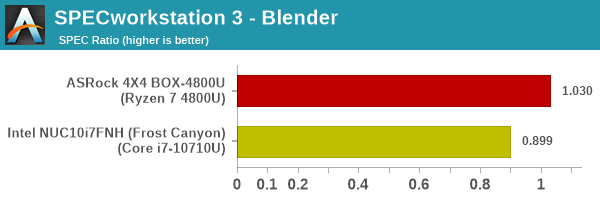
All the workloads can take advantage of the extra cores available in the Renoir APU (8 vs. 6 in the Comet Lake-U), and that helps the 4X4 BOX-4800U score handsomely over the Frost Canyon NUC.
Product Development
The Product Development category comprises of eight distinct workloads:
- The Rodinia (CFD) workload benchmarks a computational fluid dynamics (CFD) algorithm.
- The WPCcfd workload benchmarks another CFD algorithm involving combustion and turbulence modeling.
- The CalculiX workload uses the Calculix finite-element analysis program to model a jet engine turbine's internal temperature.
- The Catia workload uses the catia-05 viewset from SPECviewperf 13 to replay traces generated by Dassault Systemes' CATIA V6 R2012 3D CAD application.
- The Creo workload uses the creo-02 viewset from SPECviewperf 13 to replay traces generated by PTC's Creo, a 3D CAD application.
- The NX workload uses the snx-03 viewset from SPECviewperf 13 to replay traces generated by the Siemens PLM NX 8.0 CAD/CAM/CAE application.
- The Solidworks workload uses the sw-04 viewset from SPECviewperf 13 to replay traces generated by Dassault Systemes' SolidWorks 2013 SP1 CAD/CAE application.
- The Showcase workload uses the showcase-02 viewset from SPECviewperf 13 to replay traces from Autodesk’s Showcase 2013 3D visualization and presentation application
| SPECworkstation 3.0.4 - Product Development Workloads | |||

In GPU-intensive workloads, the Renoir APU marches well ahead of CML-U. In the couple of cases where the focus is on the CPU performance, the Renoir APU ekes out a slender lead.
Life Sciences
The Life Sciences category comprises of four distinct test sets:
- The LAMMPS set comprises of five tests simulating different molecular properties using the LAMMPS molecular dynamics simulator.
- The NAMD set comprises of three tests simulating different molecular interactions.
- The Rodinia (Life Sciences) set comprises of four tests - the Heartwall medical imaging algorithm, the Lavamd algorithm for calculation of particle potential and relocation in a 3D space due to mutual forces, the Hotspot algorithm to estimate processor temperature with thermal simulations, and the SRAD anisotropic diffusion algorithm for denoising.
- The Medical workload uses the medical-02 viewset from SPECviewperf 13 to determine system performance for the Tuvok rendering core in the ImageVis3D volume visualization program.
| SPECworkstation 3.0.4 - Life Sciences Workloads | |||
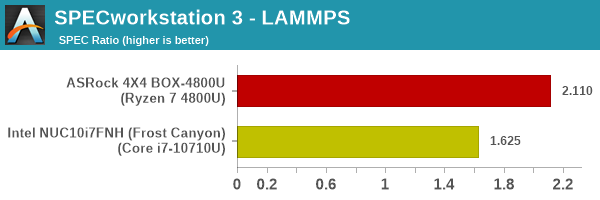
Similar to what was seen in the product development workloads, the Renoir APU marches well ahead of CML-U in the GPU-intensive tasks. In the couple of cases where the focus is on the CPU performance, the Renoir APU is still ahead.
Financial Services
The Financial Services workload set benchmarks the system for three popular algorithms used in the financial services industry - the Monte Carlo probability simulation for risk assessment and forecast modeling, the Black-Scholes pricing model, and the Binomial Options pricing model.
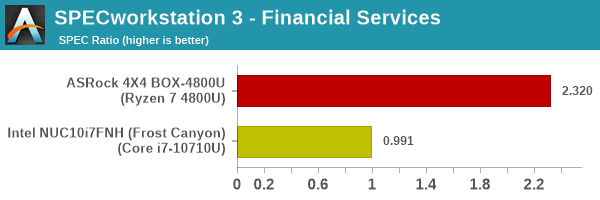
This workload is again able to take good avantage of available cores in the system, enabling the 4X4 BOX-4800U to provide more than double the performance of the Frost Canyon NUC.
Energy
The Energy category comprises of workloads simulating various algorithms used in the oil and gas industry:
- The FFTW workload computes discrete Fourier transforms of large matrices.
- The Convolution workload computes the convolution of a random 100x100 filter on a 400 megapixel image.
- The SRMP workload processes the Surface-Related Multiples Prediction algorithm used in seismic data processing.
- The Kirchhoff Migration workload processes an algorithm to calculate the back propogation of a seismic wavefield.
- The Poisson workload takes advantage of the OpenMP multi-processing framework to solve the Poisson's equation.
- The Energy workload uses the energy-02 viewset from SPECviewperf 13 to determine system performance for the open-source OPendTec seismic visualization application.
| SPECworkstation 3.0.4 - Energy Industry Workloads | |||
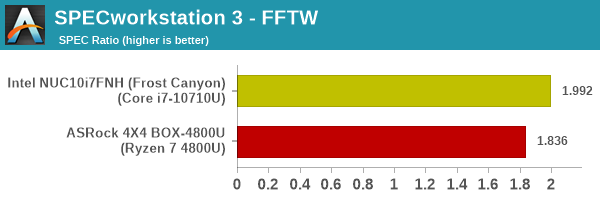
Most workloads are dependent on single-threaded performance here, with the 4X4 BOX-4800U trailing the Frost Canyon NUC in those cases.
General Operations
In the General Options category, the focus is on workloads from widely used applications in the workstation market:
- The 7zip workload represents compression and decompression operations using the open-source 7zip file archiver program.
- The Python workload benchmarks math operations using the numpy and scipy libraries along with other Python features.
- The Octave workload performs math operations using the Octave programming language used in scientific computing.
- The Storage workload evaluates the performance of the underlying storage device using transaction traces from multiple workstation applications.
| SPECworkstation 3.0.4 - General Operations | |||
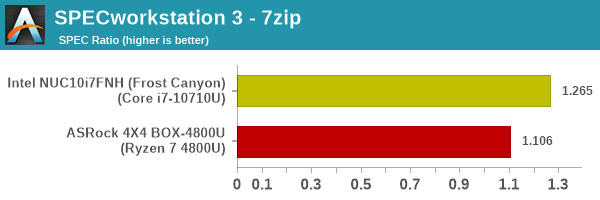
The match-up is a bit even for general operations, with the 4X4 BOX-4800U ahead in some, and the Frost Canyon NUC ahead in others (based on whether the workload is single-thread performance limited, or it is able to take advantage of a large number of cores)
GPU Compute
In the GPU Compute category, the focus is on workloads taking advantage of the GPU compute capabilities using either OpenCL or CUDA, as applicable:
- The LuxRender benchmark is the same as the one seen in the media and entertainment category.
- The Caffebenchmark measures the performance of the Caffe deep-learning framework.
- The Folding@Home benchmark measures the performance of the system for distributed computing workloads focused on tasks such as protein folding and drug design.
| SPECworkstation 3.0.4 - GPU Compute | |||
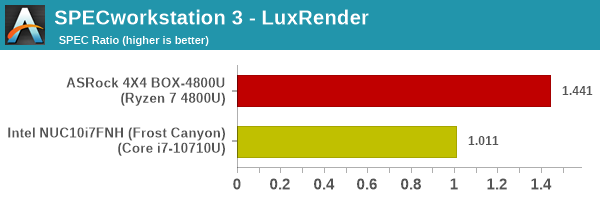
The 4X4 BOX-4800U managed to process all of the GPU compute benchmarks, but the Frost Canyon NUC couldn't process the Caffee and Folding @ Home tasks. As expected, the GPU compute performance of the AMD iGPU is better in the single workload where a comparison could be made.










53 Comments
View All Comments
damianrobertjones - Wednesday, November 25, 2020 - link
Dangerous. People are not often the brightest and help lines would probably be called when owners try to plug in a crappy usb c charger.1_rick - Thursday, November 26, 2020 - link
If your GPU can detect you didn't plug in the PCIe power plugs and refuse to let the computer boot there's no reason they can't do the same here.damianrobertjones - Monday, November 30, 2020 - link
People buy cheap chargers for phones. Nothing will change in this case.dontlistentome - Wednesday, November 25, 2020 - link
... Thunderbolt please. Can then power with it and have multiple 4K screens and peripherals hanging off 1 cable. Can then just swap the cable between this and my work PC when I work at home.timecop1818 - Wednesday, November 25, 2020 - link
Alt mode HDMI is dead, there are literally zero devices which support or implement it. It only exists as a specification. There's very little point anyway because dp alt mode is superior in every way, such as being able to reduce lane count to share usb3hs. But with hdmi alt mode, you are using all 4 lanes just to transmit 1080p.SeanFL - Wednesday, November 25, 2020 - link
Price is comparable to the Asus PN50 with the 4800U. Anyone have thoughts on which would be the one to buy?I've not been successful at finding the PN50 locally, Microcenter had a couple in stock then was sold out.
eastcoast_pete - Wednesday, November 25, 2020 - link
Thanks Ganesh! The overall performance is decent, the problems with HTPC use unfortunate. One other piece of information I might have missed: just how noisy does this unit get, and how annoying is the fan noise? I am asking as especially smaller fans can be a lot more annoying than the simple dB(A) numbers suggest. Having had a laptop with this "feature", I now always ask about that before even thinking of buying.smilingcrow - Wednesday, November 25, 2020 - link
It seems a major omission for a system that was reviewed for HTPC features and might end up in the lounge.spikebike - Wednesday, November 25, 2020 - link
Nice, been waiting for a decent NUC like product with an AMD CPU. This looks quite competitive, but seems like waiting until CES in January will be worth it. The Zen3 is a killer upgrade and might well mean it's worth keeping for another year or two.grant3 - Wednesday, November 25, 2020 - link
Most hardware refreshes are annual, and you're willing to wait 2 years? With that mindset you'll never, ever buy anything because you know a better version will eventually arrive in that timeframe. Maybe 2 better versions.